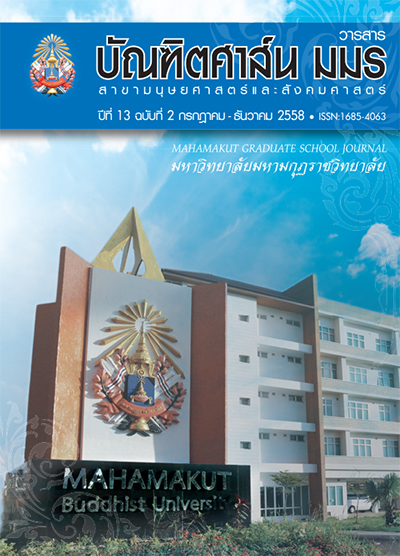ศึกษาเชิงเปรียบเทียบการบรรลุธรรมในพระพุทธศาสนาเถรวาท กับการบรรลุธรรมแบบฉับพลันในคำสอนของพระโพธิธรรม
บทคัดย่อ
วิทยานิพนธ์เรื่องนี้มีวัตถุประสงค์ 3 ประการ คือ เพื่อศึกษาการบรรลุธรรมในพระพุทธศาสนา เถรวาท เพื่อศึกษาการบรรลุธรรมแบบฉับพลันใน คำสอนของพระโพธิธรรม และเพื่อศึกษาเปรียบ เทียบการบรรลุธรรมในพระพุทธศาสนาเถรวาท กับการบรรลุธรรมแบบฉับพลันในคำสอนของพระ โพธิธรรมโดยการศึกษาข้อมูลจากคัมภีร์พระพุทธ ศาสนาเถรวาท คือ พระไตรปิฎก อรรถกถา ฎีกา และคัมภีร์อื่นๆ ที่เกี่ยวข้อง เช่น คัมภีร์วิสุทธิมรรค เป็นต้น โดยการรวบรวมข้อมูล นำมาประมวล วิเคราะห์โดยเรียบเรียงบรรยายเชิงพรรณนา และ สรุปตรวจสอบความถูกต้องโดยผู้เชี่ยวชาญ จาก การศึกษาพบว่า
การบรรลุธรรมในพระพุทธศาสนาเถรวาท หมายถึง การพัฒนาปัญญารู้แจ้งอริยสัจ 4 ตาม ระดับความแก่กล้าแห่งญาณ รู้แจ้งโลกุตตรธรรม 9 อันได้แก่มรรค 4 ผล 4 นิพพาน 1 ผู้บรรลุธรรม แล้วเรียกว่าอริยบุคคล แบ่งเป็น 4 ประเภทตาม สังโยชน์ที่ละได้คือ พระโสดาบัน ผู้ที่ละสักกาย ทิฏฐิ วิจิกิจฉา สีลัพพตปรามาสพระสกทาคามีผู้ที่ ทำราคะ โทสะ โมหะให้เบาบาง พระอนาคามี ผู้ที่ ละกามราคะ ปฏิฆะเพิ่มเข้าไปด้วยพระอรหันต์ ผู้ที่ละ รูปราคะ อรูปราคะ มานะ อุทธัจจะ อวิชชา เพิ่มเข้าไปด้วย
การบรรลุธรรมของพระโพธิธรรม ซึ่งเป็น พระภิกษุชาวอินเดีย ได้บวชและศึกษาปฏิบัติจน ได้บรรลุธรรม นับเป็นพระสังฆปรินายกองค์ที่ 28 ของนิกายเซ็น พบว่า การบรรลุธรรม หมายถึง สภาวะการรู้แจ้งแห่งสภาวะความจริงสูงสุดเป็น ประสบการณ์การรับรู้ความจริงว่า สรรพสิ่งใน จักรวาลล้วนเป็นหนึ่ง เป็นการทำลายความยึดมั่น ถือมั่นที่ทำให้เกิดการแบ่งแยกสรรพสิ่งล้วนเป็น หนึ่งเดียว หรือเป็นเพียงความว่าง มีวิธีการบรรลุ ธรรม 3 วิธี คือ ซาเซ็น คือการนั่งสมาธิ ซันเซ็น การขบคิดปริศนาธรรม และมนโด การถามตอบ อย่างฉับพลัน
ในการศึกษาเปรียบเทียบการบรรลุธรรมของ พระพุทธศาสนาเถรวาทกับการบรรลุธรรมของพระ โพธิธรรม พบวา่ ในสายเถรวาทเปน็ การูแ้ จง้ อริยสัจ 4 คือ ทุกข์ สมุทัย นิโรธ มรรค โดยมีข้อปฏิบัติ คือ การบรรลุโดยอาศัยสมถะหรือองค์ฌานเรียก ว่า สมถยานิกะ และการบรรลุโดยอาศัยวิปัสสนา ล้วนๆ เรียกว่า วิปัสสนายานิกะ และผู้บรรลุพระ อริยบุคคลก็บรรลุไปตามลำดับคือ พระโสดาบัน พระสกิทาคามี พระอนาคามี และพระอรหันต์ ด้านการบรรลุธรรม ของพระโพธิธรรมจะเป็นไป ในลักษณะบรรลุแบบฉับพลัน ซึ่งเป็นเอกลักษณ์ ของการบรรลุธรรมแบบเซ็น แม้จะเห็นเป็นความ แตกต่างกัน แต่ยังมีข้อที่เหมือนกัน คือ ผลมาจาก การสั่งสมภูมิปัญญาจนกระทั่งมากพอที่จะกำจัด อวิชชาได้ จนบรรลุธรรมในที่สุด ในส่วนภาวะทาง ปัญญาและภาวะทางจิตของผู้บรรลุธรรมของทั้ง สองนิกาย ซึ่งผู้วิจัยเห็นว่า ไม่ต่างกัน เพราะจิต ของผูห้ มดกิเลสยอ่ มเปน็ จิตที่บริสุทธิ์ ถึงพรอ้ มดว้ ย ปัญญา และความเมตตา กรุณา เพื่อทำประโยชน์ แก่สังคมโดยส่วนรวม
เอกสารอ้างอิง
ก. ข้อมูลปฐมภูมิ มหาจุฬาลงกรณราชวิทยาลัย. พระไตรปิฎกภาษาไทยฉบับมหาจุฬาลงกรณราชวิทยาลัย. กรุงเทพมหานคร: โรงพิมพ์มหาจุฬาลงกรณราชวิทยาลัย, 2539.
มหามกุฏราชวิทยาลัย. พระไตรปิฎกพร้อมอรรถกถา แปล ชุด 91 เล่ม.กรุงเทพมหานคร: โรงพิมพ์มหามกุฏราช วิทยาลัย, 2534.
ข. ข้อมูลทุติยภูมิ
(1) หนังสือ:
ธีระ วงศ์โพธิ์พระ. ศิษย์โง่ไปเรียนเซ็น ฉบับเซียนท้ออายุยืน รวมเล่มพิเศษ 1, 2, 3 และ4. พิมพ์ครั้งที่ 1.กรุงเทพมหานคร: สํานักพิมพ์สุขภาพใจ, 2535.
บุญมี แท่นแก้ว. พระพุทธศาสนาในเอเชีย (ด้านอารยธรรม). กรุงเทพมหานคร: โอเดียนสโตร์. 2548.
บุรัญชัย จงกลนี รศ.ดร.เซ็น ปฏิบัติ. พิมพ์ครั้งที่ 1. กรุงเทพมหานคร: สํานักพิมพ์เพชรประกาย, 2550.
พระเทพเวที (ประยุทธ์ ปยุตฺโต).พระพุทธศาสนาในอาเซีย.กรุงเทพมหานคร: ธรรมสภา.2540.
พุทธทาสภิกขุ.สูตรของเว่ยหล่าง.กรุงเทพมหานคร: สุขภาพใจ, 2547.
สุมาลี มหณรงค์ชัย.พุทธศาสนามหายาน.กรุงเทพมหานคร: ศยาม, 2546.
เสถียร โพธินันทะ.ปรัชญามหายาน.กรุงเทพมหานคร: โรงพิมพ์มหามกุฎราชวิทยาลัย, 2548.
พระโสภณมหาเถระ (มหาสีสยาดอ). วิปัสสนานัย เล่ม 2. พระพรหมโมลี (สมศักดิ์ อุปสโมป.ธ.9, M.A. Ph.D.) ตรวจ ชําระ.พระคันธสาราภิวงศ แปลและเรียบเรียง.นนทบุรี: ไทยร่มเกล้า,2548.
ดาวน์โหลด
เผยแพร่แล้ว
รูปแบบการอ้างอิง
ฉบับ
ประเภทบทความ
สัญญาอนุญาต
บทความวิชาการและบทความวิจัยในวารสารฉบับนี้ถือเป็นความรับผิดชอบของผู้เขียนเท่านั้น บทความที่ได้รับการตีพิมพ์ในวารสารบัณฑิตศาส์น ถือเป็นลิขสิทธิ์ของมหาวิทยาลัยมหามกุฏราชวิทยาลัย ตามพระราชบัญญัติลิขสิทธิ์



